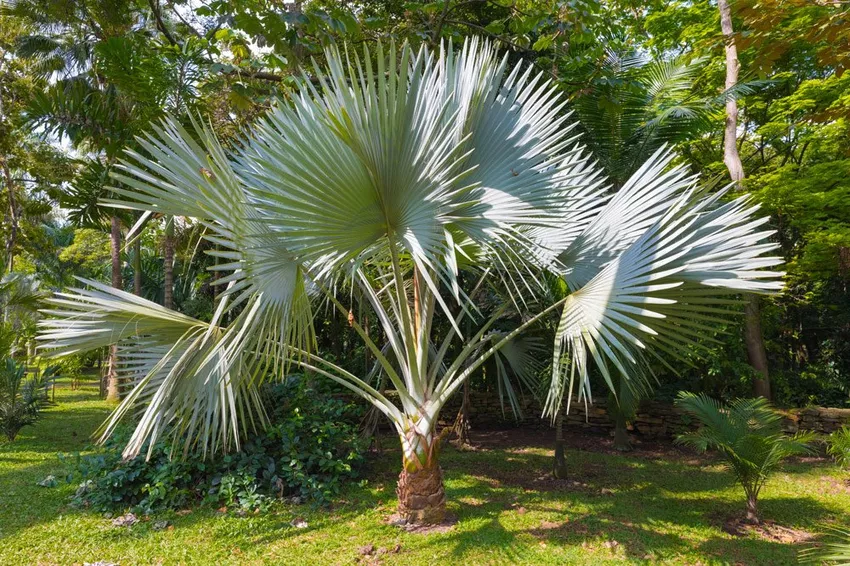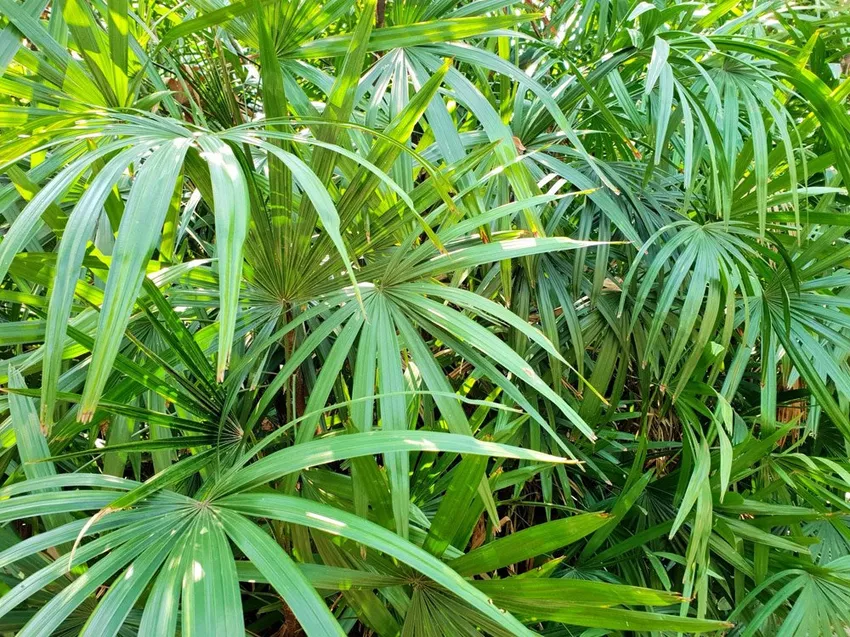Palm trees give your garden a southern flair. We introduce you to 7 species that can remain in the garden even in winter.
 Sun, beach and palm trees - in the face of this postcard idyll, it is difficult to believe that the exotic plants also feel at home in our latitudes and can even survive the winter unscathed. This is possible with some palm trees because they are considered hardy. Some robust representatives of this species will now be presented in more detail.
Sun, beach and palm trees - in the face of this postcard idyll, it is difficult to believe that the exotic plants also feel at home in our latitudes and can even survive the winter unscathed. This is possible with some palm trees because they are considered hardy. Some robust representatives of this species will now be presented in more detail.
Which palm trees are hardy?
If you want to bring tropical flair to your home all year round, you should buy hardy palm trees. However, the term should be used with caution. The plants are often only frost hardy and need special protection in severe frosts.
An attempt at year-round outdoor cultivation can be made with the following palms.
Blue Dwarf Palm (Chamaerops humilis)
 With its silver-blue foliage, the blue dwarf palm is an eye-catcher. Their natural home is in the Atlas Mountains of Morocco. The plants are used to a harsh climate and are among the robust palm trees that can be overwintered in the garden without any problems.
With its silver-blue foliage, the blue dwarf palm is an eye-catcher. Their natural home is in the Atlas Mountains of Morocco. The plants are used to a harsh climate and are among the robust palm trees that can be overwintered in the garden without any problems.
Care Instructions:
- Sun to partial shade
- pour piercing
- Let the soil dry out
- April to September apply complete fertilizer
What should be considered in winter?
Slight frost is tolerated. For a short time, temperatures can drop to -10 degrees. The fronds should be covered with garden fleece. This represents a protection for the trunk tips. The new fronds develop from these so-called "palm hearts". The root area should be covered with leaves or brushwood. If there is severe frost, the fleece cover can be padded with leaves or straw. This should only be done for a short time, since the plant also needs a lot of light in winter.
Chinese Hemp Palm (Trachycarpus fortunei)
 The hemp palm is a real eye-catcher with its strong fronds, which are reminiscent of fans. The imposing plants can reach heights of up to four meters. In early summer, the Chinese hemp palm is adorned with yellow-green flowers. In mild locations, the palm tree can grow outdoorshibernate. Protective measures are required in severe frosts.
The hemp palm is a real eye-catcher with its strong fronds, which are reminiscent of fans. The imposing plants can reach heights of up to four meters. In early summer, the Chinese hemp palm is adorned with yellow-green flowers. In mild locations, the palm tree can grow outdoorshibernate. Protective measures are required in severe frosts.
Care Instructions:
- Sun to partial shade
- Keeping possible
- pour piercing
- Let the soil dry out
- Water several times on hot days
- April to September apply complete fertilizer every two weeks
What should be considered in winter?
If the first frost is announced, the fronds are tied together like a tuft at the top and are covered with garden fleece. The fleece is not attached to warm the plant, but to protect it from the harsh winter sun and the ingress of moisture. With dry leaves, the palm fronds can be protected from the cold under the fleece. However, this should not prevent the penetration of daylight. The fleece covering must be tight and must not allow moisture to penetrate.
Palm Lily (Yucca)
 Yuccas are sturdy plants that grow low and can be accommodated in any garden. Expressive panicles of flowers reminiscent of lilies sprout from the palm-like tuft in midsummer. Yuccas survive the winter in beds, but are sensitive to moisture.
Yuccas are sturdy plants that grow low and can be accommodated in any garden. Expressive panicles of flowers reminiscent of lilies sprout from the palm-like tuft in midsummer. Yuccas survive the winter in beds, but are sensitive to moisture.
Care Instructions:
- sunny, hot location
- protected location
- Avoid waterlogging
- watering weekly
- Administer complete fertilizer between April and August
What should be considered in winter?
Yuccas are among the hardy palms that can withstand severe frosts. Different species react differently to low temperatures. Therefore, individual care needs must be taken into account. A cover of leaves or brushwood protects against frost. It is important that not too much moisture gets into the soil around the plant, even in winter.
Blue Needle Palm (Trithrinax campestris)
 These imposing palm trees can reach heights of six to seven meters. Blue-grey leaves with their leaf tips covered with thorns stand out. The natural home of the blue needle palm is in Argentina. There the palm trees grow in dry forest areas. Larger plants also defy severe frosts. But must be protected from moisture in winter.
These imposing palm trees can reach heights of six to seven meters. Blue-grey leaves with their leaf tips covered with thorns stand out. The natural home of the blue needle palm is in Argentina. There the palm trees grow in dry forest areas. Larger plants also defy severe frosts. But must be protected from moisture in winter.
Care Instructions:
- Sun to partial shade
- Light
- Water moderately
- The soil must not be too damp
What should be considered in winter?
Between November and March, the blue needle palm does not receive water. For the plant should if possible a coveredlocation can be found. In winter, a layer of fallen leaves, hay or straw can protect. Fully grown plants tolerate temperatures down to -15 degrees.
Canary Island Date Palm (Phoenix canariensis)
 The vigorous palm trees with their spreading fronds can grow up to 15 meters high outdoors. As a container plant, the Canary date palm stays much smaller. The palms form fruits from late winter, which, in contrast to the real date palm, are not suitable for consumption. The palm survives mild winters outdoors. Potted plants belong in the house.
The vigorous palm trees with their spreading fronds can grow up to 15 meters high outdoors. As a container plant, the Canary date palm stays much smaller. The palms form fruits from late winter, which, in contrast to the real date palm, are not suitable for consumption. The palm survives mild winters outdoors. Potted plants belong in the house.
Care Instructions:
- Sun to partial shade
- pour piercing
- Let the soil dry out
- April to September weekly fertilizers
- Use a complete fertilizer or nitrogen fertilizer for green plants
What should be considered in winter?
Potted plants should be kept bright and frost-free indoors over the winter. Temperatures between five and ten degrees are ideal. In the open air, the palms can survive short-term minus temperatures in the single-digit range. A winter protection of garden fleece and leaves should be given. It is important to water the palm even in dry winters. The soil must dry well between waterings.
Wagner's Hemp Palm (Trachycarpus wagnerianus)
 Wagner's hemp palm is a little known and quite undemanding plant. The maximum growth height is about five meters. The crown can reach about half the diameter. The crown appears small and delicate and is adorned with light and dark green foliage.
Wagner's hemp palm is a little known and quite undemanding plant. The maximum growth height is about five meters. The crown can reach about half the diameter. The crown appears small and delicate and is adorned with light and dark green foliage.
Care Instructions:
- Sun to partial shade
- suitable for keeping in buckets
- water only when dry outdoors
- additional watering on hot days
- Palm fertilizer every two to three weeks
What should be considered in winter?
In mild locations, winter protection is not absolutely necessary. If the frost reaches double digits, even Wagner's hemp palm cannot do without protection from garden fleece, leaves or straw. The fronds are tied up like a tuft.
Palmetto Palm (Sabal palmetto)
 This eye-catching fan palm is a special ornament in the home garden. While the trunk is rather inconspicuous, the imposing leaves are impressive. The plants, which are still quite rare in our gardens, feel better outdoors than in pots. In our latitudes, growth heights of up to ten meters can be reached. In its original home, the palmettoPalm more than twice as tall.
This eye-catching fan palm is a special ornament in the home garden. While the trunk is rather inconspicuous, the imposing leaves are impressive. The plants, which are still quite rare in our gardens, feel better outdoors than in pots. In our latitudes, growth heights of up to ten meters can be reached. In its original home, the palmettoPalm more than twice as tall.
Care Instructions:
- Sun to partial shade
- pour enough
- Let the soil dry out
- April to September apply complete fertilizer
What should be considered in winter?
The fronds must be tied together before the frost. This allows the palm to be better protected from moisture. A loose covering of garden fleece is advisable. For a short time, the palm trees tolerate temperatures down to minus ten degrees.
General tips for hardy palm trees
Even if the mentioned palm trees are designated as hardy, very few exotic trees survive the cold season without our help. Potted plants are particularly at risk when frost sets in. The problem here does not lie in the winter hardiness of the planting, but in the fact that the plant pot can freeze through quickly and the plants are thus deprived of their food base.
If the palm tree in the tub cannot move into the house, a sheltered location under a canopy can be found. Freezing wetness is a great enemy of plants during the cold season.
Tip: You can avoid freezing the planter by placing the pot on a block of wood or styrofoam.
The plant pot is covered with garden fleece and padded with leaves or straw.
The ground area of outdoor palm trees should also be covered with straw, leaves or mulch. This maintains the moisture balance in the soil and provides additional frost protection.
Tip: If the palm tree has to be wrapped in garden fleece over a longer period of time during severe frosts, light-colored fleece is more suitable. The light transmission must not be restricted too much.
What happens after winter?
After the winter, the palm trees have to be gradually accustomed to the usual growth conditions. Container plants are not immediately exposed to full sun, the palm fronds could burn.
After removing the winter protection, discolored and dried fronds can be removed. The administration of a nutrient-rich long-term fertilizer makes you fit for the new gardening season.